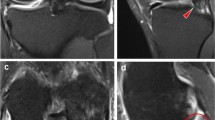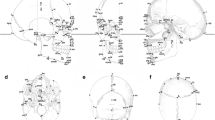Abstract
In this study, the body segment parameters of Koreans were estimated using two-dimensional CT images of cadavers. A software instrument was developed in this study for the image analyses. The software converts 2D images into 3D images and reconstructs the full-body image to automatically distinguish and divide it into fat, bone, and muscle tissues, depending on the body components. The body segments were manually separated by joints, and the software automatically calculated the average mass, volume, and center of gravity of the body segment, and the results were used to analyze the relationship between the body segments and the body characteristics and to build a regression model with statistical significance. The regression model can estimate the mass and volume of segments based on the gender, height, and weight. The software instrument was able to rapidly analyze full-body CT images, and it allows users to easily repeat the analysis.
Similar content being viewed by others
References
W. T. Dempster, Space requirements of the seated operator, Wright Air Development Center, Aerospace Medical Research Laboratory, TR-55-159, Ohio, Wright-Patterson Air Force Base (1955).
C. E. Clauser, J. T. McConville and J. W. Young, Weight, volume, and center of mass of segments of the human body, Aerospace Medical Research Laboratory, TR-69-70, Ohio, Wright-Patterson AirForce Base (1969).
R. F. Chandler, Investigation of inertia properties of the human body, Aerospace Medical Research Laboratory, TR-74-137, Ohio, Wright-Patterson AirForce Base (1975).
J. W. Young, Anthropometric and mass distribution characteristics of the adult female, Aerospace Medical Research Laboratory, TR-83-16, Ohio, Wright-Patterson AirForce Base (1983).
R. K. Jensen, Body segment mass, radius and radius of gyration proportions of children, Journal of Biomechanics, 19 (1986) 359–368.
T. Yokoi, K. Shibukawa and M. Ae, Body segment parameters of Japanese children, Japanese Journal of Physical Education, 31 (1986) 53–66.
J. T. McConville, Anthropometric relationships of body and body segment moments of inertia, Aerospace Medical Research Laboratory, TR-80-119, Ohio, Wright-Patterson Air-Force Base (1980).
H. K. Lim, A study on the inertia characteristics of body segments of korean male in twenties-mass, Center of Mass, and Movement of Inertia Characteristics, MS Thesis, Chungnam National University, Daejeon, Korea (1994).
S. J. Park, C. B. Kim and S. C. Park, Anthropometric and biomechanical characteristics on body segments of Koreans, Applied human science, 18(3) (1999) 91–99.
Y. Ma, J. H. Kwon, Z. Mao, K. W. Lee, L. Li and H. Y. Chung, Segment inertial parameters of Korean adults estimated from three-dimensional body laser scan data, International Journal of Industrial Ergonomics, 41(1) (2011) 19–29.
V. M. Zatsiorsky and V. N. Seluyanov, The mass and inertia characteristics of the main segments of the human body, Biomechanics YIII-B (1983) 1152–1159.
L. Jennifer, Durkin, James J. Dowling and David M. Andrews, The measurement of body segment inertial parameters using dual energy X-ray absorptiometry, Journal of Biomechanics, 35 (2002) 1575–1580.
C. J. Jung, The biomechanical body segment parameters of korean male adults. Ph. D. Dissertation, Seoul National University, Seoul, Korea (1993).
D. J. Pearsall and J. G. Reid, Inertial properties of the human trunk of males determined from magnetic resonance imaging, Annals of Biomedical engineering, 22 (1994) 692–706.
Y. S. Kim, Estimation of body mass of korean adult males using magnetic resonance image, Ph. D. Dissertation, Sungkyunkwan University, Seoul, Korea (1999).
C. K. Cheng, Segment inertial properties of Chinese adults determined from magnetic resonance imaging, Clinical biomechanics, 15 (2000) 559–566.
NLM, http://www.nlm.nih.gov/research/visible/visiblehuman.html (1997).
G. X. Ritter and J. N. Wilson, Handbook of computer vision algorithms in image algebra, CRC Press, USA, FL (1996).
M. H. Chang and Y. C. Chung, Efficiency of grid representation and its algorithms for areal 3D scan data, Journal of Mechanical Science and Technology, 23 (2009) 1234–1243.
Todd Elvins, A survey of algorithms for volume visualization, Computer Graphics, 26(3) (1992) 191–201.
Digital Korean Homepage, http://digitalman.kisti.re.kr.
Cameron, John R., James G. Skofronick and Roderick M. Grant, Physics of the Body, Second Edition. Madison, WI, Medical Physics Publishing (1999).
J. Yang, R. Chiou, A. Ruprecht, J. Vicario, L. A. MacPhail and T. E. Rams, A new device for measuring density of jaw bones, Dento maxillo facial radiology, 31(5) (2002) 313–316.
Samuel R. Ward and Richard L. Lieber, Density and hydration of fresh and fixed human skeletal muscle, Journal of Biomechanics, 38(11) (2005) 2317–2320.
M. S. Farvid, T. W. K. Ng, D. C. Chan, P. H. R. Barrett and G. F. Watts, Association of adiponectin and resisting with adipose tissue compartments, insulin resistance and dyslipidaemia, Journal of Pharmacology and Therapeutics, 7(4) (2005) 406–413.
D. A. Winter, Biomechanics and motor control of human movement, 2nd edition, John Wiley & Sons, Canada, Toronto (1990).
S. R. Sreekanta, J. W. Park, S. W. Ra and S. Shimuzu, Obese measurement using CT Images, The Second BERC Biometrics Workshop, Yonsei University, Korea (2004) 264–267.
S. W. Byun, Three-dimensional computer graphics in otology, Korean Journal of Otorhinolaryngology-Head and Neck Surgery, 52 (2009) 104–112.
Author information
Authors and Affiliations
Corresponding author
Additional information
Recommended by Associate Editor Yoon Hyuk Kim
Seong-Bin Park received his B.S. and M.S. in industrial engineering from Dongeui University, Korea in 2007. He is currently a researcher in Wellness technology R&D center at Korea institute of industrial technology. His research interests include human performance, ergonomics design, and applied statistics.
Sa-Yup Kim received his B.S. degree in electronic engineering from Yeungnam University, Korea, in 2002. He received his M.S. degree in biomedical engineering from Yonsei University, Korea in 2005. He is currently a senior researcher in Wellness technology R&D center at Korea institute of industrial technology. His research interests include aging, biomechanics.
Joon-Ho Hyeong received his B.S. and M.S. degree in industrial design engineering from Korea University of Technology and Education, Korea in 2007. He is currently a researcher in Wellness technology R&D center at Korea institute of industrial technology. His research interests include design engineering, goods design and biomechanics
Kyung-Ryul Chung received his B.S. degree in mechanical engineering from Seoul National University, Korea, in 1981. He received his M.S. and Ph.D in mechanical engineering from KAIST, Korea in 1987. He is currently a principal researcher in Wellness technology R&D center at Korea institute of industrial technology. His research interests include wellness system, system engineering and design engineering.
Rights and permissions
About this article
Cite this article
Park, SB., Kim, SY., Hyeong, JH. et al. A study on the development of image analysis instrument and estimation of mass, volume and center of gravity using CT image in Korean. J Mech Sci Technol 28, 971–977 (2014). https://doi.org/10.1007/s12206-013-1168-6
Received:
Revised:
Accepted:
Published:
Issue Date:
DOI: https://doi.org/10.1007/s12206-013-1168-6




